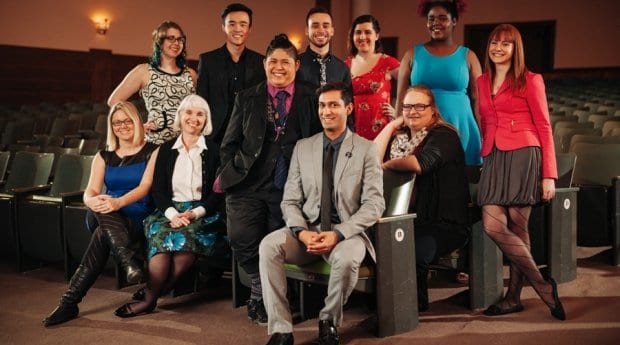After a decade of working to combat bullying, homophobia, transphobia and other forms of discrimination in schools and youth communities, Jer’s Vision has evolved beyond being a podium for its charismatic founder, Jeremy Dias.
It has transformed, instead, into a platform for the creative energies of its diverse staff members, who are burnishing the group’s LGBT activism with their own feminist and decolonialist perspectives. That’s the message trumpeted by Dias. Jer’s Vision has evolved, but the challenges and successes of the group’s advocacy work over the past decade are monumental. Still, Dias remains humble.
“I really haven’t achieved that much, to be honest,” he says. “I work with a really fantastic team — I just do payroll and government grants. Although I do get to do a lot of programming, which is fun.”
Reflecting on the organization that bears his name, Dias says Jer’s Vision “isn’t about me anymore” and credits his co-workers for their efforts to improve it. To that end, his team is reportedly mulling a name change to the Canadian Centre for Gender and Sexual Diversity to better reflect its shifting structure. “We have ‘Jer’s Vision’ on the wall, and we were breaking down what it meant,” Dias recalls of a recent board meeting. “One of the board members asked, ‘Whose vision is it anyway?’ And it hasn’t been my vision for a really long time.”
Placing Dias as the creative leader of Jer’s Vision is an understandable impulse. In addition to serving as executive director, he’s the most recognizable public face of the organization and has made a number of high-profile television appearances, on Canada AM, MuchMusic, CTV News, Global News and CBC News. He has also served as a keynote speaker at an array of conferences and events.
But Dias maintains that he is hardly a one-man show. “When you talk about the work that we do, and as soon as you say our name, everything gets placed at my feet, and it’s not my work,” he says. Much of the credit for the organization’s continuing success is owed to those he works with, he adds.
Perhaps best known for organizing the annual International Day of Pink, where students are encouraged to wear pink to school as a symbol of support for anti-bullying measures, Jer’s Vision runs and supports a range of workshops, educational programs and community initiatives. Its focus on promoting inclusiveness and tolerance in schools has won the group national and international attention, as pressure increasingly grows on school officials to fight youth bullying in the wake of several notorious incidents of students committing suicide after enduring harassment from their peers.
It’s an issue close to Dias’s heart.
After coming out as gay in his early teens, he regularly faced severe bullying and discrimination at his high school in Sault Ste Marie. His efforts to effect change were met with resistance from school administrators, leading him, at the age of 17, to file a claim against the school and school board with the Ontario Human Rights Commission.
Three years later, Dias emerged victorious and was awarded a financial settlement that he used to start Jer’s Vision.
A decade later there remains much more work to do for the LGBT community, Dias says, even after high-profile victories like the legalization of same-sex marriage. But he admits that driving that message home isn’t always easy. He describes a celebration party after the federal Liberal government passed historic legislation heralding marriage equality where he met then–prime minister Paul Martin, who, Dias says, asked him why he would start a queer organization after “all the issues are over.”
“I remember looking at him and saying, ‘Well, because they’re not,’” Dias says. “We have yet to win the hearts and minds of Canadians. It’s great that you can get married, but if you’re a trans kid from Sault Ste Marie, getting surgery and hormones is really, really tough.”
It’s tough, however, to downplay the strides made to improve tolerance and acceptance of LGBT people in schools across the country. Dias notes that a member of Jer’s Vision is actively preparing the group’s inaugural LGBT educators’ conference — to be held mere days after the International Day of Pink — to train and educate those affected by the Ontario government’s passage of the Accepting Schools Act. He cites a number of examples of positive efforts from those involved with the conference to improve the experience for LGBT students in the province, including creating gay-straight alliances in Catholic schools, instituting a gender-neutral bathroom at an elementary school and inaugurating a weekly Day of Pink event at a suburban school with an openly gay principal. “It’s amazing to see that it’s not just wearing a pink shirt; it’s living a pink pledge of values and behaviours about resolving conflicts and treating each other differently,” Dias says.


 Why you can trust Xtra
Why you can trust Xtra


